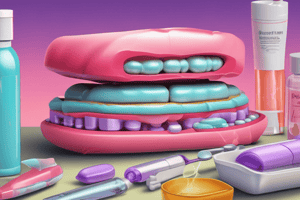Podcast
Questions and Answers
What is a primary benefit of brushing teeth in bedridden patients?
What is a primary benefit of brushing teeth in bedridden patients?
- Prevents tooth decay and cavities (correct)
- Enhances bone density
- Improves eyesight
- Reduces skin infections
Which adaptive device for brushing helps individuals with limited grip strength hold the toothbrush more securely?
Which adaptive device for brushing helps individuals with limited grip strength hold the toothbrush more securely?
- Ergonomic toothbrush
- Electric toothbrush
- Weighted toothbrush
- Toothbrush with universal cuff (correct)
Which of the following complications can arise from poor oral hygiene?
Which of the following complications can arise from poor oral hygiene?
- Improved digestion
- Enhanced respiratory function
- Increased muscle strength
- Systemic infections (e.g., pneumonia) (correct)
What is the correct initial step in the technique of hand washing?
What is the correct initial step in the technique of hand washing?
What is one purpose of nail care in bedridden patients?
What is one purpose of nail care in bedridden patients?
Which type of toothbrush is specifically designed to provide extra weight for individuals with shaky hands?
Which type of toothbrush is specifically designed to provide extra weight for individuals with shaky hands?
What is a potential consequence of inadequate oral hygiene in bedridden patients?
What is a potential consequence of inadequate oral hygiene in bedridden patients?
What should be checked during the procedure of nail care?
What should be checked during the procedure of nail care?
What should be the position of a bedridden patient during brushing to ensure the mouth is accessible?
What should be the position of a bedridden patient during brushing to ensure the mouth is accessible?
What is the recommended amount of toothpaste to apply when brushing a bedridden patient's teeth?
What is the recommended amount of toothpaste to apply when brushing a bedridden patient's teeth?
Which area should be targeted specifically during the brushing process after cleaning the teeth?
Which area should be targeted specifically during the brushing process after cleaning the teeth?
How should a caregiver monitor a bedridden patient during the brushing process?
How should a caregiver monitor a bedridden patient during the brushing process?
What technique should be used when brushing a patient's teeth?
What technique should be used when brushing a patient's teeth?
For patients with respiratory issues, what is the best positioning during tooth brushing?
For patients with respiratory issues, what is the best positioning during tooth brushing?
When should a toothbrush be replaced for optimal oral care?
When should a toothbrush be replaced for optimal oral care?
What is the purpose of documenting oral care activities?
What is the purpose of documenting oral care activities?
Flashcards are hidden until you start studying
Study Notes
Brushing Teeth
- Positioning:
- Semi-Fowler Position: Elevate the head of the bed to 30-40 degrees. Use pillows or wedges to support the patient's head and neck.
- Lateral Position: Patient lies on their side, head slightly elevated. Use pillows or wedges. Brush the upper side first, then turn the patient to brush the lower side.
- Supine Position: Patient lies on their back with the head elevated 30-40 degrees. Use pillows or wedges.
- Prepare the Mouth:
- Remove oral secretions using a suction device or oral aspirator.
- Clean with water or saline solution.
- Topical anesthetic can be applied if necessary.
- Brushing:
- Use a soft-bristled toothbrush. Apply a pea-sized amount of fluoride toothpaste.
- Brush in small circular motions. Focus on gum lines, chewing surfaces, and areas around dental appliances.
- Target Specific Areas:
- Brush the tongue and roof of the mouth.
- Clean around dental appliances.
- Brush the gum line.
- Rinsing:
- Rinse the mouth with water.
- Use a suction device to remove excess water.
- Removal: Remove the toothbrush and dispose of oral secretions.
- Documentation: Record oral care activities and any issues or concerns.
Benefits of Brushing Teeth
- Prevents tooth decay and cavities.
- Reduces the risk of gum disease.
- Prevents bad breath.
- Maintains oral comfort and dignity.
- Prevents infections.
- Supports nutrition and hydration.
- Enhances overall quality of life.
- Reduces the risk of respiratory infections.
- Prevents complications from dry mouth.
Complications of Poor Oral Hygiene
- Tooth decay and cavities.
- Gum disease.
- Bad breath.
- Dental work complications.
- Systemic infections, like pneumonia.
- Malnutrition and weight loss.
- Decreased quality of life.
Adaptive Devices for Brushing
- Ergonomic Toothbrushes: Larger, cushioned handles or angled designs for easier grip and maneuverability.
- Electric Toothbrushes: Automatic brushing action, requiring less manual effort - some models have timers and pressure sensors.
- Toothbrush with Universal Cuff: A cuff or strap attaches to the hand and toothbrush for better grip.
- Weighted Toothbrush: Extra weight to help individuals with shaky hands.
- Adapted Handle or Extensions: Easier reach for those with limited reach or conditions like arthritis.
Hand Washing
- Remove jewelry from hands and wrists.
- Wet hands and forearms with water and soap.
Nail Care
- Trim nails short periodically.
- Keep nails clean by frequent washing.
Purposes of Nail Care
- Make nails clean and harmless.
- Prevent infection.
- Prevent dirt accumulation under nails.
- Enhance the patient’s general appearance.
Nail Care Procedure
- Check the condition of fingers, toes, and nails for dryness, inflammation, and cracking.
- Explain the procedure to the patient.
- Wash hands with soap and water.
- Maintain privacy.
Studying That Suits You
Use AI to generate personalized quizzes and flashcards to suit your learning preferences.




